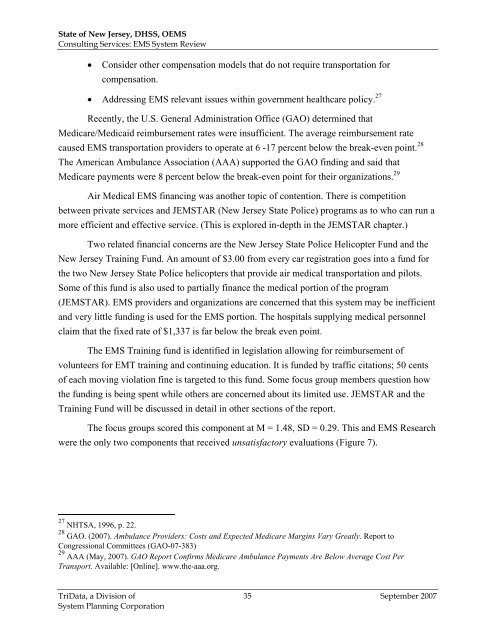EMS System Review - State of New Jersey
EMS System Review - State of New Jersey
EMS System Review - State of New Jersey
- No tags were found...
Create successful ePaper yourself
Turn your PDF publications into a flip-book with our unique Google optimized e-Paper software.
<strong>State</strong> <strong>of</strong> <strong>New</strong> <strong>Jersey</strong>, DHSS, O<strong>EMS</strong>Consulting Services: <strong>EMS</strong> <strong>System</strong> <strong>Review</strong>• Consider other compensation models that do not require transportation forcompensation.• Addressing <strong>EMS</strong> relevant issues within government healthcare policy. 27Recently, the U.S. General Administration Office (GAO) determined thatMedicare/Medicaid reimbursement rates were insufficient. The average reimbursement ratecaused <strong>EMS</strong> transportation providers to operate at 6 -17 percent below the break-even point. 28The American Ambulance Association (AAA) supported the GAO finding and said thatMedicare payments were 8 percent below the break-even point for their organizations. 29Air Medical <strong>EMS</strong> financing was another topic <strong>of</strong> contention. There is competitionbetween private services and J<strong>EMS</strong>TAR (<strong>New</strong> <strong>Jersey</strong> <strong>State</strong> Police) programs as to who can run amore efficient and effective service. (This is explored in-depth in the J<strong>EMS</strong>TAR chapter.)Two related financial concerns are the <strong>New</strong> <strong>Jersey</strong> <strong>State</strong> Police Helicopter Fund and the<strong>New</strong> <strong>Jersey</strong> Training Fund. An amount <strong>of</strong> $3.00 from every car registration goes into a fund forthe two <strong>New</strong> <strong>Jersey</strong> <strong>State</strong> Police helicopters that provide air medical transportation and pilots.Some <strong>of</strong> this fund is also used to partially finance the medical portion <strong>of</strong> the program(J<strong>EMS</strong>TAR). <strong>EMS</strong> providers and organizations are concerned that this system may be inefficientand very little funding is used for the <strong>EMS</strong> portion. The hospitals supplying medical personnelclaim that the fixed rate <strong>of</strong> $1,337 is far below the break even point.The <strong>EMS</strong> Training fund is identified in legislation allowing for reimbursement <strong>of</strong>volunteers for EMT training and continuing education. It is funded by traffic citations; 50 cents<strong>of</strong> each moving violation fine is targeted to this fund. Some focus group members question howthe funding is being spent while others are concerned about its limited use. J<strong>EMS</strong>TAR and theTraining Fund will be discussed in detail in other sections <strong>of</strong> the report.The focus groups scored this component at M = 1.48, SD = 0.29. This and <strong>EMS</strong> Researchwere the only two components that received unsatisfactory evaluations (Figure 7).27 NHTSA, 1996, p. 22.28 GAO. (2007). Ambulance Providers: Costs and Expected Medicare Margins Vary Greatly. Report toCongressional Committees (GAO-07-383)29 AAA (May, 2007). GAO Report Confirms Medicare Ambulance Payments Are Below Average Cost PerTransport. Available: [Online]. www.the-aaa.org.TriData, a Division <strong>of</strong> 35September 2007<strong>System</strong> Planning Corporation



